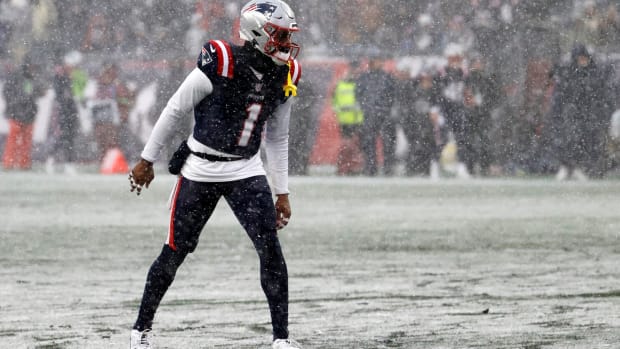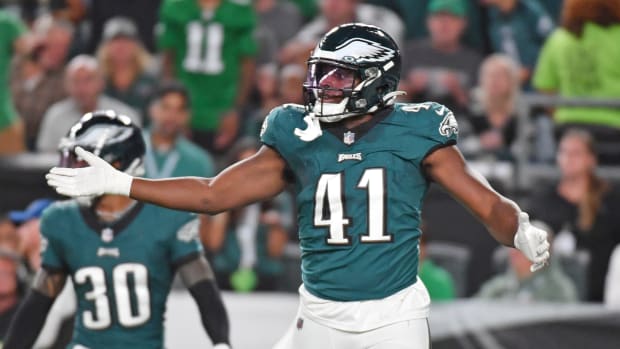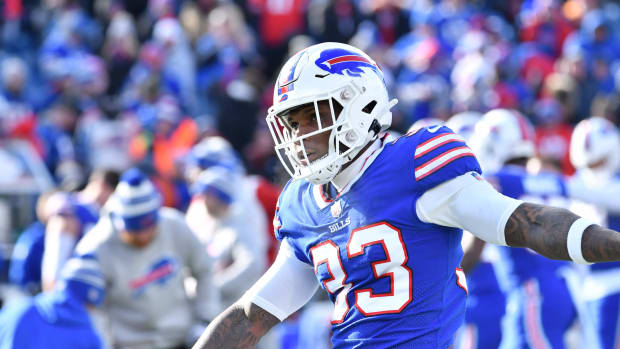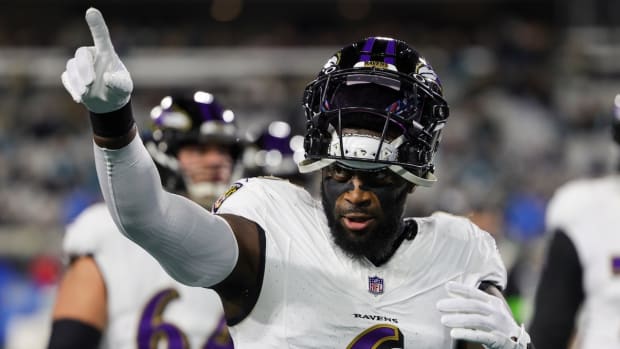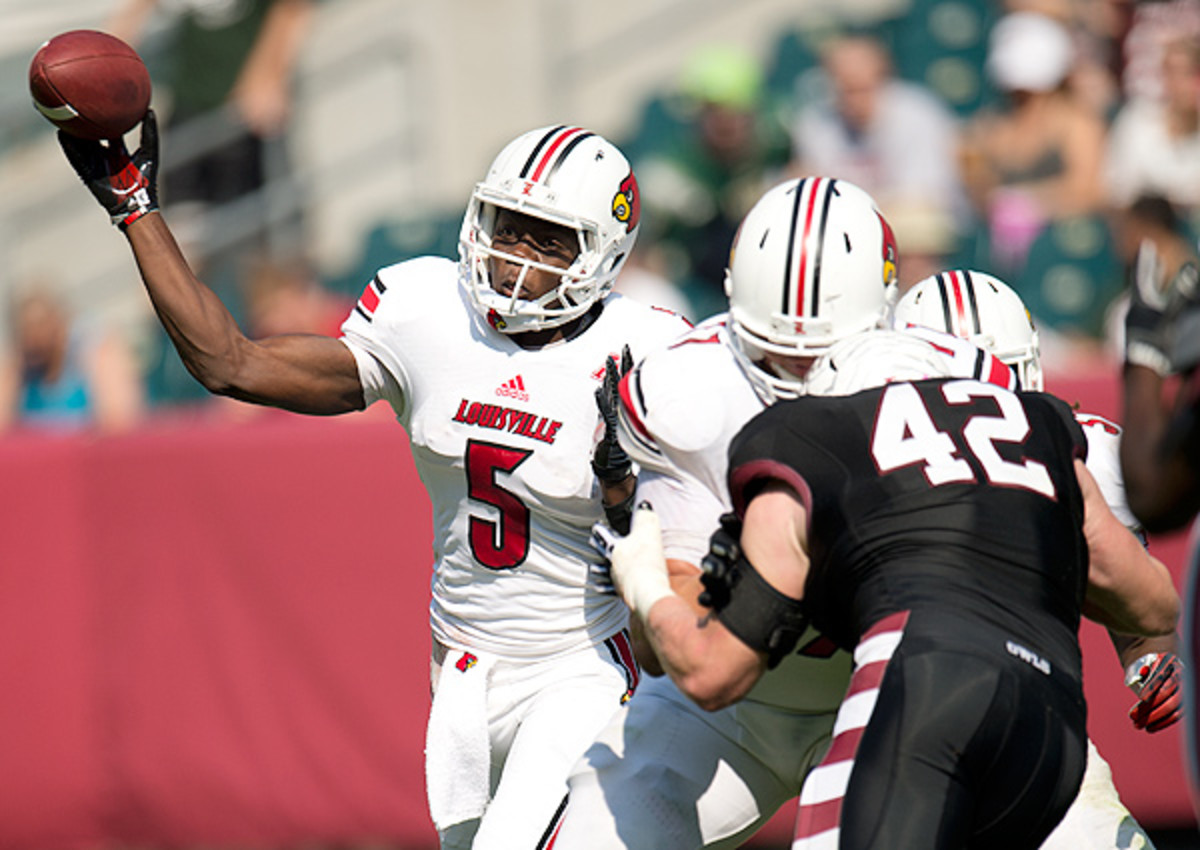
Mobile franchise QB, shutdown corner among hardest positions to find in draft
Could Teddy Bridgewater become the NFL's next great franchise quarterback? (Al Tielemans/SI)
NFL teams have positional pillars that are crucial to long-term success, but within that construct, the goalposts keep moving. A generation ago, you wanted a franchise running back above all, and safeties were afterthoughts for the most part. Ten years ago, any quarterback who primarily played out of the shotgun in college was seen as an outlier at best, and an unworkable prospect at worst. And even five years ago, who would have predicted the rising importance of slot receivers, and the nickel and dime cornerbacks tasked with covering them?
As the NFL switches its needs from year to year, the value of specific positions rises and falls accordingly. With the 2014 draft approaching, here are six positions of crucial importance and the prospects who can best fill them.
MORE: 2014 NFL Mock Draft | 2014 NFL draft needs: AFC | NFL draft needs: NFC
Mobile franchise quarterback
Best NFL example: Andrew Luck
While the NFL still welcomes the stationary passer if he's got a golden arm, the trend favors mobile quarterbacks who can extend plays and split defensive coverages with their pure running skills. And while most of the attention in this regard goes to guys like Robert Griffin III, Cam Newton and Russell Wilson, it's been Andrew Luck who has combined athleticism and efficiency more effectively than any quarterback in recent years. Like Steve McNair, Steve Young, and the later versions of Randall Cunningham, Luck has essentially welded all the key components of truly great quarterback play onto the physique of a player who could run a few routes, if need be.
"He has pump-fakes and he does things that Peyton [Manning] does, but his athletic ability supersedes anyone I've ever coached, even Ben [Roethlisberger]," current Arizona Cardinals head coach and former Colts and Steelers offensive coordinator Bruce Arians said of Luck in October 2013. "I think Ben is a phenomenal athlete for his size, but Andrew doesn't get the credit for the athlete that he is."
The top three QB prospects in this class all combine these attributes in different measures, though not at Luck's level.
Teddy Bridgewater, Louisville -- Bridgewater has an edge in that he clearly runs to throw -- he keeps his eyes downfield and looks for open receivers no matter what. He's an effective mobile passer because he maintains his mechanics even when on the run.
Johnny Manziel, Texas A&M -- Sometimes transcendent, occasionally incomprehensible -- that's the on-field swing you'll get from Manziel. Like Russell Wilson, he has an innate sense of how to stay alive behind the line of scrimmage while defenses adjust and coverages split.
Blake Bortles, UCF -- Bortles might be the first quarterback taken in this class, because he's the one with prototypical size (6-5, 230 pounds), a very good arm and sneaky mobility when he needs it. He'll need to move beyond the single-read concepts he got away with in college, though.
Tackling Carlos Hyde is never a pleasant proposition. (Jonathan Daniel/Getty Images)
Bellwether running back
Best NFL example: Adrian Peterson
There's no question that, on a lot of NFL teams, the running back position has decreased in importance -- on the field, in the draft and when it comes to eventual paydays. Still, there are those teams that depend on a power running game above all else. The 49ers and Seahawks, who faced off in the NFC Championship Game and might have the league's most compelling current rivalry, certainly do.
There's no better example of a player who manages to constantly transcend the inconsistencies around him than Adrian Peterson of the Vikings. Peterson overcame a major knee injury in 2011 to rush for 2,097 yards in '12, and 1,266 last season, despite facing extra defenders in the box on just about every attempt because Minnesota's quarterbacks and receivers have been inconsistent at best over the last few seasons.
While not one of the top backs in the 2014 draft shows Peterson's characteristics, they all have every-down potential in the right system.
Carlos Hyde, Ohio State -- At 6-0 and 230, Hyde has the build and power to bull through defenders, but he can also elude surprisingly well in space, and he looks good when flying out to catch the ball. He's best set up to be that franchise back.
Tre Mason, Auburn -- Mason seems to be the perfect cross between the lighter, more agile back, and the player who will gain extra yards with root strength. Any team in need of a "one-cut-and-go" guy would do well to look him up in the second round.
Bishop Sankey, Washington -- While Sankey also has power, he really shines as a do-it-all back in the Brian Westbrook mold. He's a fine receiver and pass-blocker, so there's little chance that his NFL quarterback will boot him off the field at any point in time.
Greg Robinson is a physical freak with as much upside as you'd ever want. (Pouya Dianat/SI)
Plug-and-play left tackle
Best NFL example: Joe Thomas
And for that mobile QB, it's still important to have a blind-side protector. That's why the top NFL left tackles have been among the game's highest-paid non-quarterbacks. That said, it takes time for a great left tackle to become great. The top three tackles taken in the 2013 draft (Eric Fisher, Luke Joeckel, Lane Johnson) allowed a total of 21 sacks in their rookie seasons, per Pro Football Focus, and that's with Joeckel missing 11 games due to an ankle injury and a lot of right tackle snaps thrown in. Like referees, offensive linemen are generally not talked about unless they screw up, which is one reason Cleveland's Joe Thomas isn't often discussed when the game's greatest current players are discussed. But Thomas has never missed a game in his NFL career -- he was selected with the third overall pick in the 2007 draft -- and in 2013, he allowed just two sacks, nine quarterback hits and 26 quarterback hurries in 752 passing snaps. And that was on a team in which the quarterback situation was a complete and total dumpster fire.
Put simply, the best left tackles do their jobs at a ridiculously high level, no matter the circumstance or supporting cast. The three best tackles in this class (by general consensus) could hit that mark over time, with a few tweaks in their games.
Jake Matthews, Texas A&M -- Matthews' father, Bruce, is a Hall of Fame center/guard, and the former Aggie comes to the NFL with the technical precision you'd expect. Not the most physically imposing tackle, but he understands technique and leverage, and shows it snap after snap.
Greg Robinson, Auburn -- Robinson has the most enticing athletic upside of any lineman in this class. He could be plug-and-play with a power-running team, where his embryonic pass-blocking wouldn't be as much of a problem. His NFL team will have to teach and adjust, but he's worth the time.
Taylor Lewan, Michigan -- Lewan is the left tackle from central casting, and he plays like it for the most part. There are occasional lapses on and off the field, but he's a first-round talent.
[si_video id="video_0593589B-0A70-3583-4FC9-B3BB0F873B9B" height="470"]
Khalil Mack (46) is one of the most dynamic players in this draft class. (Kevin Tanaka/AP)
Three-down inside linebacker
Best NFL example: NaVorro Bowman
NFL teams are rotating their defenders more than ever, which makes the every-down linebacker who can tackle against the run and cover the pass a real standout. Over the last couple of years, the paradigm for inside linebackers has shifted with NFL teams looking for lighter, faster players, and it's tough to argue that San Francisco's NaVorro Bowman is among the best at the position. In fact, some feel that he's eclipsed teammate Patrick Willis in some areas of the game, if ever so slightly. A First-Team All-Pro in each of his last three seasons, the third-round pick in 2010 has eclipsed all expectations by improving in several areas through his NFL career, especially pass coverage.
"He sure has been playing at a very high level," 49ers head coach Jim Harbaugh said of Bowman last December. "Consistently great, week in and week out. You could even say the last four or five ballgames, I mean, he's elevated that play ... He's just been outstanding and deserves to be mentioned in that kind of [MVP] company."
Bowman is currently recovering from a knee injury suffered in the NFC Championship Game. While he does so, these three 'backers hope to enter the league and continue this kind of on-field legacy.
C.J. Mosley, Alabama -- Few 'backers are smarter and take better angles, and he has an ability to smack ballcarriers all over the field that's reminiscent of the great Derrick Brooks at times.
Khalil Mack, Buffalo -- A possible top-five pick whose name is gaining buzz. Primarily a blitzer, and that's where he'll make his money, but he can also force the issue against the run and surprise in coverage.
Ryan Shazier, Ohio State -- Shazier fits the NFL's current preference for the lighter linebacker with burning field speed. He's not an intimidator, but he moves with great quickness from Point A to Point B. Didn't blitz a lot in college, but could be a factor with quarterback pressure.
Justin Gilbert (left) boosted his draft stock with an impressive combine. (J.P. Wilson/Icon SMI)
Shutdown press cornerback
Best NFL example: Richard Sherman
The truly dominant boundary cornerback who can erase the opponent's best receiver is perhaps the rarest entity in the NFL. Richard Sherman, Darrelle Revis and Patrick Peterson define their defenses. And in 2013, Sherman set himself apart with a season for the ages. In the regular season (per Pro Football Focus), Sherman was targeted just 58 times on 549 passing snaps, allowing 30 receptions for 421 yards and two touchdowns. And in that league-low target rate, Sherman picked off eight passes, and proved to be nearly impossible to beat on deep, straight routes of any type. In the postseason, Sherman was even better, allowing just two receptions on seven targets in 116 passing snaps. It was clear late in the Super Bowl, when Peyton Manning threw the ball away deep instead of risking a long attempt to Demaryius Thomas, that Sherman had reached a point where he was confounding every quarterback he faced.
“I think one of the things ... there’s a number of things that make him so unique, but he’s got extreme recall: formations, plays, information from this game, last season, last week and he can recall it fast," Seahawks defensive coordinator Dan Quinn said of Sherman during the week leading up to the Super Bowl. "My first experience with that was I think when we were getting ready to play Carolina in the opener and he said, 'Last year this, this, this' and so it was without even getting into the gameplan that week, he had some formations and some alerts he remembered already. So, I think the mental quickness for him when he sees information, he can transfer it so quickly. Almost like a quarterback that has that kind of quickness, he has that at corner.”
Sherman took determination, raw physical talent and great intelligence to the top of the mountain. Each of these three draft prospects may be able to do the same ... in time. Because the true shutdown corner? That's tough to find.
Justin Gilbert, Oklahoma State -- With a fluid playing style and sub-4.4 speed, Gilbert has the tools for the shutdown paradigm. Aggression is a key component of his game -- he makes receivers earn their openings.
Kyle Fuller, Virginia Tech -- The best technician at his position. It's hard to watch Fuller's tape and find obvious flaws. He's special because he can play off-coverage as well as he presses.
Bradley Roby, Ohio State -- Roby can be too grabby in coverage, but he'll go high in the draft because he sticks to receivers like glue -- he's like a shorter Richard Sherman in that regard.
Calvin Pryor plays free safety the way you have to -- like his hair is on fire. (Andy Lyons/Getty Images)
Coverage safety
Best NFL example: Earl Thomas
Free safeties are tasked with everything from slot defense to deep center field coverage. The safety who can take a receiver from the snap to an infinite line upfield will find his pockets lined sooner than later. The Saints gave former Bills safety Jairus Byrd a six-year, $54 million contract with $26.3 million guaranteed in March because Byrd has the ability to do everything on that list. And just this week, the Seahawks made Earl Thomas (who may have been the NFL's best defensive player in 2013) the highest-paid safety on a per-season basis with a four-year, $40 million contract extension that includes $27.725 million guaranteed. Thomas defined the league's best defense in 2013 with demonic closing speed, hyper-aggressive tackling and an intensity that rubbed off on all his teammates ... and coaches.
“It would be different," Seahawks head coach Pete Carroll recently told me when I asked how Seattle's defense would look without Thomas. "We would adapt to whatever our players do, but Earl gives us this tremendous range and versatility -- he can cover slot receivers, he can cover wide receivers, and he takes great pride in that. He fits the run beautifully. We can fit him in wherever we want him to, in all kinds of special personnel packages. So, he’s just extraordinarily well-rounded, and he gives us a variety of things we can do. However, we play to his strengths, and his strength is that tremendous range he has on the deep end. There’s really nobody like him.”
True, but each of these draftable safeties [especially Pryor] have the potential to eventually enter that Byrd/Thomas realm.
Calvin Pryor, Louisville -- Pryor is a fast, violent player whose game is based more on explosion than anticipation. And he's got the knack for jumping routes as the best cornerbacks would. A flashy player whose talents run deep -- and all over the field.
Ha Ha Clinton-Dix, Alabama -- Clinton-Dix flashes down to help with run support like most Nick Saban pass defenders, but he also shows that he can backpedal on deep passes and stay with any receiver.
Jimmie Ward, Northern Illinois -- There are concerns about the strength of his competition, but there's no doubting Ward's raw skills -- he covers from outside to the deep middle with aggression and demon speed.
[si_video id="video_B982CB82-D4F9-BC1B-D6EA-B3B97B6F178C" height="470"]







































